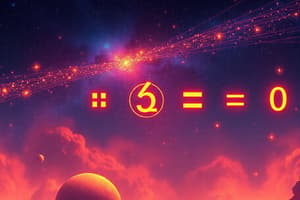Podcast
Questions and Answers
Which term refers to a reaction where one element reacts with another to form a compound containing both elements?
Which term refers to a reaction where one element reacts with another to form a compound containing both elements?
- Decomposition reaction
- Combination reaction (correct)
- Unimolecular reaction
- Single-step reaction
What is the result of a combination reaction in chemistry?
What is the result of a combination reaction in chemistry?
- Creation of a compound with different elements from the reactants (correct)
- Production of a compound with the same elements as reactants
- Formation of a single pure element
- Release of energy without any new substance formed
When ice melts into water, which statement is correct regarding the elements involved?
When ice melts into water, which statement is correct regarding the elements involved?
- Ice becomes a mixture of hydrogen and oxygen
- Oxygen changes state from gas to solid
- Hydrogen and oxygen form a chemical bond (correct)
- Hydrogen separates from oxygen
What is a common misconception about combination reactions in chemistry?
What is a common misconception about combination reactions in chemistry?
Which aspect is crucial for understanding the properties of atoms and molecules within different states of matter?
Which aspect is crucial for understanding the properties of atoms and molecules within different states of matter?
Why is understanding chemical bonds between different kinds of atoms important in chemistry?
Why is understanding chemical bonds between different kinds of atoms important in chemistry?
What is the main purpose of stoichiometry in chemistry?
What is the main purpose of stoichiometry in chemistry?
How does stoichiometry help ensure there is enough product formed from starting materials?
How does stoichiometry help ensure there is enough product formed from starting materials?
What role does stoichiometry play in determining limiting reagents?
What role does stoichiometry play in determining limiting reagents?
How does stoichiometry assist in predicting the remaining molecules after a reaction?
How does stoichiometry assist in predicting the remaining molecules after a reaction?
Which method is commonly used in stoichiometry calculations to count moles of elements?
Which method is commonly used in stoichiometry calculations to count moles of elements?
What is an essential aspect of stoichiometry for chemists conducting experiments?
What is an essential aspect of stoichiometry for chemists conducting experiments?
Study Notes
In the realm of chemistry, the term "+"1 chemistry" refers to a specific type of reaction where one element reacts with another to create a compound containing both elements. This process is also known as combination reactions, which result in a product that contains two or more different types of elements. One example of this would be the melting of ice into water, where hydrogen combines with oxygen in a chemical bond to make liquid water. A common misconception might be that these reactions involve only one simple step; however, they often occur through multiple stages involving several intermediate steps.
The products formed during these reactions can exist in various states of matter, including solids, liquids, gases, and plasmas. For instance, when you heat ice to form steam, it goes from being solid water to gas. These four basic physical states of matter are crucial to understanding the properties of atoms and molecules within them, such as density and temperature.
In summary, "+1 chemistry" deals with the formation of compounds by combining distinct elements, resulting in new materials with unique characteristics based on their state of matter. Understanding how chemical bonds work between different kinds of atoms is key to comprehending why certain combinations produce particular states of matter, which has wide-ranging implications across many fields of study, from biology to engineering.
Studying That Suits You
Use AI to generate personalized quizzes and flashcards to suit your learning preferences.
Description
Explore the world of +1 Chemistry, where elements combine to form compounds in a series of reactions. Learn about the different states of matter that these compounds can exist in and how they influence their properties. Delve into the significance of chemical bonds and their role in creating diverse materials.




